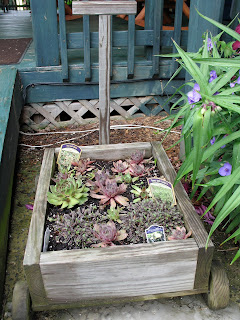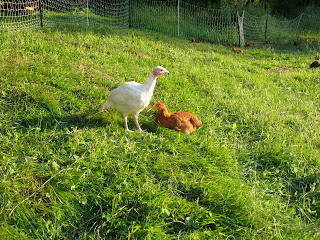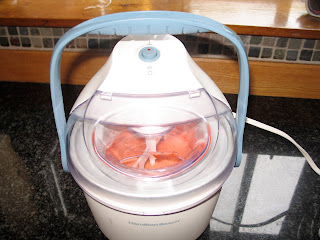This is a side shot of the front flower beds and the hanging pots I've just put up. The front flower beds contain boxwood in the back, day lilies in the middle, and green and white
hostas in the front. The day lilies are just beginning to bloom. The day lilies throughout our property were given to us by our friends in West Virginia and Northern Virginia; some were also transplanted from the townhouse in Northern Virginia. Therefore, I don't know the species of each day lily. However, I do know that most of them are the typical orange variety that is native to this area. They are often seen growing wild on the side of the road at this time of year. I cannot wait for these day lilies to fully bloom. Once that happens, I will replace the photograph on the lodge's web page with one of the day lilies in full bloom.
The hanging pots contain white trailing petunias, yellow
gerber daisies, and yellow-green sweet potato vine. Every year, I try to mix up the annuals I choose for the hanging pots because it keeps the view interesting.

This is a close-up of the front bed with the green and white
hostas in the front and the reddish-orange day lily beginning to bloom in the background.

These dark pink and light pink
astilbe in the shade garden are just beginning to bloom.
Astilbe are medium sized plants that produce a big airy plume in the summer. They bloom for several weeks, and they are also available in white, peach, red, and purple. DH has promised that he will fix the gutter this week so that I can fully mulch this bed. It should look pretty nice by then because most of the perennials are settling in quite nicely.

This photograph is a close-up of the friendship garden. The purple and white
japanese iris, pink peonies, and bearded iris are no longer blooming. Only the purple
salvia, which I discussed in-depth in the last blog remains. The purple
salvia located in the back of the bed is currently being crowded out by day lilies and
japanese iris, so I will definitely have to thin this bed out later this fall. The orange day lilies and yellow brown-eyed
susans are beginning to bloom and this bed should be full of them by next weekend. Since purple and orange don't contrast well with each other, I will shear the
salvia next weekend.

This is a close-up of the budget gardens that I started last year. I am quite happy with the way it is turning out. The only items that were purchased for this bed were the
itea virginica henry plants in the background, which I purchased at a discount price from a seller on
ebay; the dark green "big blue"
liriope; and the edging in the front of the bed. I transplanted the light green
liriope from the townhouse, and the lamb's ear and
hostas from another site at the lodge. A few of the
hostas were gifts from friends.

This is the naturalized perennial bed. The purple native phlox and
japanese iris are no longer
blooming, and the white daisies are near the end of their bloom cycle. The bright colored perennials of summer, including orange day lilies, yellow
gloriosa daisies, and red bee balm, are beginning to take their place. I have a half dozen pink
asiatic lilies in this bed that are just beautiful, but I will probably transplant them this fall or next spring because the pink color does not contrast very well with the other summer flowers.

This is a close-up photo of the orange day lilies and white
daisies that are blooming in the naturalized perennial bed.

There are currently seven perennials blooming in the full-sun perennial bed:
scabiosa butterfly blue, veronica royal candles,
nepata walker's low
catmint,
spiderwort, purple clematis, delphinium, and a wayward
asiatic lily. This photograph is a close-up of the full-sun perennial bed. It contains low-growing aster and lamb's ear in the foreground. The aster will bloom later this fall. Tall white delphinium, a cottage-garden favorite, are located in the center of the photograph, and a flower box with white and purple petunias, yellow-green sweet potato vine, and a blue annual are located in the background. DH purchased the delphinium for me shortly after we purchased the lodge, and it has done well. I recently purchased blue delphinium to add to this bed. The plants are still living, and, hopefully, they will grow as tall as the white ones next year. Delphiniums produce large spikes of elegant looking flowers. The taller varieties, such as the ones pictured here, require hooping or staking. Otherwise, the tall stems will break during summer thunderstorms.

This is another close-up of the full sun perennial bed. Left to right, there is dark purple clematis blooming. Below it is purple
spiderwort; the locals around here call it "Job's tears." This perennial forms dense spreading clumps of erect narrow strap-like leaves. This perennial was one of the few that was here when we bought the lodge. In fact, it inspired the colors scheme and design of the entire full sun perennial bed because I didn't want to disturb it. The dark-purple three-petaled flowers bloom for a few weeks at the beginning of every summer. The interesting little flowers close up every afternoon, but they reopen every morning. It is a carefree perennial that comes back every year. Tall Russian sage is located in the center of the photograph. It as supposed to be a medium height plant, but it must be very happy because, as you can see, it is growing taller than the window boxes. It will bloom later this summer. Finally, in the right of the photo is
nepata walker's low
catmint. This plant does not produce the most beautiful flowers, but I love it because it is such a long bloomer. It really helps to carry the perennial beds through weeks when few other flowers are blooming, and amazingly enough, my cats don't bother it.

Last but not least, I completed this little project a couple of weeks ago. I absolutely love
sempervivum (hens and chicks), and I have a difficult time resisting purchasing them. I saw these 2 varieties at a local garden tent that sets up shop for a few weeks in the Spring in a Giant grocery store parking lot in Falls Church, VA. The "hens" were just humongous, so I had to have them. However, I really didn't have any place to put them, so I filled this little wooden wagon with them.


















































